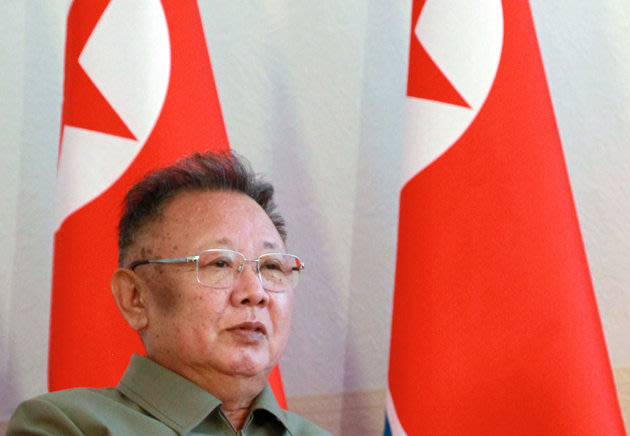North Korean leader Kim Jong Il, 69, has died
By JEAN H. LEE 
SEOUL, South Korea — Kim Jong Il, North Korea's mercurial and enigmatic leader whose iron rule and nuclear ambitions dominated world security fears for more than a decade, has died. He was 69.
Kim's death 17 years after he inherited power from his father was announced Monday by the state television from the North Korean capital, Pyongyang. The country's "Dear Leader" — reputed to have had a taste for cigars, cognac and gourmet cuisine — was believed to have had diabetes and heart disease.
North Korea has been grooming Kim's third son to take over power from his father in the impoverished nation that celebrates the ruling family with an intense cult of personality.
South Korea put its military on "high alert" and President Lee Myung-bak convened a national security council meeting after the news of Kim's death.
In a "special broadcast" Monday, state media said Kim died of a heart ailment on a train due to a "great mental and physical strain" on Saturday during a "high intensity field inspection."
Kim is believed to have suffered a stroke in 2008 but he had appeared relatively vigorous in photos and video from recent trips to China and Russia and in numerous trips around the country carefully documented by state media.
Kim Jong Il inherited power after his father, revered North Korean founder Kim Il Sung, died in 1994. He had been groomed for 20 years to lead the communist nation founded by his guerrilla fighter-turned-politician father and built according to the principle of "juche," or self-reliance.
In September 2010, Kim Jong Il unveiled his third son, the twenty-something Kim Jong Un, as his successor, putting him in high-ranking posts.
Even with a successor, there had been some fear among North Korean observers of a behind-the-scenes power struggle or nuclear instability upon the elder Kim's death.
Few firm facts are available when it comes to North Korea, one of the most isolated countries in the world, and not much is clear about the man known as the "Dear Leader."
North Korean legend has it that Kim was born on Mount Paekdu, one of Korea's most cherished sites, in 1942, a birth heralded in the heavens by a pair of rainbows and a brilliant new star.
Soviet records, however, indicate he was born in Siberia, in 1941.
Kim Il Sung, who for years fought for independence from Korea's colonial ruler, Japan, from a base in Russia, emerged as a communist leader after returning to Korea in 1945 after Japan was defeated in World War II.
With the peninsula divided between the Soviet-administered north and the U.S.-administered south, Kim rose to power as North Korea's first leader in 1948 while Syngman Rhee became South Korea's first president.
The North invaded the South in 1950, sparking a war that would last three years, kill millions of civilians and leave the peninsula divided by a Demilitarized Zone that today remains one of the world's most heavily fortified.
In the North, Kim Il Sung meshed Stalinist ideology with a cult of personality that encompassed him and his son. Their portraits hang in every building in North Korea and on the lapels of every dutiful North Korean.
Kim Jong Il, a graduate of Pyongyang's Kim Il Sung University, was 33 when his father anointed him his eventual successor.
Even before he took over as leader, there were signs the younger Kim would maintain — and perhaps exceed — his father's hard-line stance.
South Korea has accused Kim of masterminding a 1983 bombing that killed 17 South Korean officials visiting Burma, now known as Myanmar. In 1987, the bombing of a Korean Air Flight killed all 115 people on board; a North Korean agent who confessed to planting the device said Kim ordered the downing of the plane himself.
Kim Jong Il took over after his father died in 1994, eventually taking the posts of chairman of the National Defense Commission, commander of the Korean People's Army and head of the ruling Worker's Party while his father remained as North Korea's "eternal president."
He faithfully carried out his father's policy of "military first," devoting much of the country's scarce resources to its troops — even as his people suffered from a prolonged famine — and built the world's fifth-largest military.
Kim also sought to build up the country's nuclear arms arsenal, which culminated in North Korea's first nuclear test explosion, an underground blast conducted in October 2006. Another test came in 2009.
Alarmed, regional leaders negotiated a disarmament-for-aid pact that the North signed in 2007 and began implementing later that year.
However, the process continues to be stalled, even as diplomats work to restart negotiations.
North Korea, long hampered by sanctions and unable to feed its own people, is desperate for aid. Flooding in the 1990s that destroyed the largely mountainous country's arable land left millions hungry.
Following the famine, the number of North Koreans fleeing the country through China rose dramatically, with many telling tales of hunger, political persecution and rights abuses that officials in Pyongyang emphatically denied.
Kim often blamed the U.S. for his country's troubles and his regime routinely derides Washington-allied South Korea as a "puppet" of the Western superpower.
U.S. President George W. Bush, taking office in 2002, denounced North Korea as a member of an "axis of evil" that also included Iran and Iraq. He later described Kim as a "tyrant" who starved his people so he could build nuclear weapons.
"Look, Kim Jong Il is a dangerous person. He's a man who starves his people. He's got huge concentration camps. And ... there is concern about his capacity to deliver a nuclear weapon," Bush said in 2005.
Kim was an enigmatic leader. But defectors from North Korea describe him as an eloquent and tireless orator, primarily to the military units that form the base of his support.
The world's best glimpse of the man was in 2000, when the liberal South Korean government's conciliatory "sunshine" policy toward the North culminated in the first-ever summit between the two Koreas and followed with unprecedented inter-Korean cooperation.
A second summit was held in 2007 with South Korea's Roh Moo-hyun.
But the thaw in relations drew to a halt in early 2008 when conservative President Lee Myung-bak took office in Seoul pledging to come down hard on communist North Korea.
Disputing accounts that Kim was "peculiar," former U.S. Secretary of State Madeleine Albright characterized Kim as intelligent and well-informed, saying the two had wide-ranging discussions during her visits to Pyongyang when Bill Clinton was U.S. president.
"I found him very much on top of his brief," she said.
Kim cut a distinctive, if oft ridiculed, figure. Short and pudgy at 5-foot-3, he wore platform shoes and sported a permed bouffant. His trademark attire of jumpsuits and sunglasses was mocked in such films as "Team America: World Police," a movie populated by puppets that was released in 2004.
Kim was said to have cultivated wide interests, including professional basketball, cars and foreign films. He reportedly produced several North Korean films as well, mostly historical epics with an ideological tinge.
A South Korean film director claimed Kim even kidnapped him and his movie star wife in the late 1970s, spiriting them back to North Korea to make movies for him for a decade before they managed to escape from their North Korean agents during a trip to Austria.
Kim rarely traveled abroad and then only by train because of an alleged fear of flying, once heading all the way by luxury rail car to Moscow, indulging in his taste for fine food along the way.
One account of Kim's lavish lifestyle came from Konstantin Pulikovsky, a former Russian presidential envoy who wrote the book "The Orient Express" about Kim's train trip through Russia in July and August 2001.
Pulikovsky, who accompanied the North Korean leader, said Kim's 16-car private train was stocked with crates of French wine. Live lobsters were delivered in advance to stations.
A Japanese cook later claimed he was Kim's personal sushi chef for a decade, writing that Kim had a wine cellar stocked with 10,000 bottles, and that, in addition to sushi, Kim ate shark's fin soup — a rare delicacy — weekly.
"His banquets often started at midnight and lasted until morning. The longest lasted for four days," the chef, who goes by the pseudonym Kenji Fujimoto, was quoted as saying.
Kim is believed to have curbed his indulgent ways in recent years and looked slimmer in more recent video footage aired by North Korea's state-run broadcaster.
Kim's marital status wasn't clear but he is believed to have married once and had at least three other companions. He had at least three sons with two women, as well as a daughter by a third.
His eldest son, Kim Jong Nam, 38, is believed to have fallen out of favor with his father after he was caught trying to enter Japan on a fake passport in 2001 saying he wanted to visit Disney's Tokyo resort.
His two other sons by another woman, Kim Jong Chul and Kim Jong Un, are in their 20s. Their mother reportedly died several years ago.











 But with construction under way at several projects, protests have broken out, led by civil society groups, activists and students’ organizations. Activists such as Medha Patkar have thrown their weight behind the agitators.
But with construction under way at several projects, protests have broken out, led by civil society groups, activists and students’ organizations. Activists such as Medha Patkar have thrown their weight behind the agitators.  The Muddy River
The Muddy River  Shillong, Dec 17 : Meghalaya's top government woman officer and a former Federation Cup champion archer, Matsiewdor War, has been selected as one of the officials for the 2012 London Olympics.
Shillong, Dec 17 : Meghalaya's top government woman officer and a former Federation Cup champion archer, Matsiewdor War, has been selected as one of the officials for the 2012 London Olympics. 

